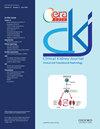血液净化疗法在治疗慢性肾病相关瘙痒症中的作用:系统性综述
IF 3.9
2区 医学
Q1 UROLOGY & NEPHROLOGY
引用次数: 0
摘要
背景 慢性肾脏病相关性瘙痒症(CKD-aP)是透析患者常见的并发症,药物治疗和透析治疗无法完全解决这一问题。目的 回顾体外血液净化方式对 CKD-aP 影响的文献。研究对象:年龄≥ 18 岁的慢性透析患者。筛选标准 在 2024 年 2 月之前,系统检索了 PubMed、Embase 和 Medline,比较不同透析方式对瘙痒强度影响的临床研究。两名审稿人独立提取数据。使用 Cochrane 工具评估了 RCT 的偏倚风险。纳入的干预措施包括任何用于治疗 CKD-aP 的体外血液净化疗法。结果 通过有效的瘙痒量表对瘙痒强度进行量化。结果综述 本综述纳入了 8 项研究透析模式的 RCT、3 项研究透析模式的观察性研究和 6 项评估 4 种透析模式的前瞻性临床试验。这些治疗方法包括腹膜透析、低通量透析、高通量透析、血液透析滤过、扩大血液透析、血液吸收、血液透析滤过与内源性再灌注以及使用 PMMA 膜的透析。大多数研究的偏倚风险都很高。血液吸附疗效的证据最多。证据的局限性包括诊断工具和治疗方法的异质性、选择偏倚的风险、样本量小以及随访时间短,这些因素使得进行可靠的系统回顾和荟萃分析具有挑战性。释义 尽管透析患者中瘙痒症的发病率很高,但除了血液吸收外,目前透析治疗的证据还很薄弱。需要更多高质量的研究来证实透析治疗的长期益处。本文章由计算机程序翻译,如有差异,请以英文原文为准。
The role of blood purification therapies in the treatment of chronic kidney disease-associated pruritus: a systematic review
Background Chronic kidney disease-associated pruritus (CKD-aP) is a common complication in dialysis patients not fully addressed by pharmacological and dialytic therapy. Objective to review the literature on the effects of extracorporeal blood purification modalities on CKD-aP. Population patients aged ≥ 18 years on chronic dialysis. Selection criteria PubMed, Embase, and Medline were systematically searched until February 2024 for clinical studies comparing the effect of different dialysis modalities on pruritus intensity. 2 reviewers extracted data independently. Risk of bias for RCTs was assessed using the Cochrane tool. Intervention any extracorporeal blood purification therapy for the treatment of CKD-aP was included. Outcomes quantitative change in pruritus intensity on a validated itching scale. Synthesis of results This review included 8 RCTs examining 5 different dialysis modalities, 3 observational studies examining 3 dialysis modalities, and 6 prospective clinical trials assessing 4 dialysis modalities. These treatments included peritoneal dialysis, low-flux, and high-flux dialysis, hemodiafiltration, expanded hemodialysis, hemadsorption, hemodiafiltration with endogenous reinfusion, and dialysis with PMMA membrane. Risk of bias was high in most studies. The largest body of evidence was found for the efficacy of hemadsorption. Limitations of evidence heterogeneity in diagnostic tools and treatment, risk of selection bias, small sample sizes, and short follow-up durations that made it challenging to perform a robust systematic review and meta-analysis. Interpretation Despite the high prevalence of pruritus among dialysis patients, except for hemadsorption, current evidence for dialytic treatment is weak. More high-quality studies are needed to confirm the long-term benefits.
求助全文
通过发布文献求助,成功后即可免费获取论文全文。
去求助
来源期刊

Clinical Kidney Journal
Medicine-Transplantation
CiteScore
6.70
自引率
10.90%
发文量
242
审稿时长
8 weeks
期刊介绍:
About the Journal
Clinical Kidney Journal: Clinical and Translational Nephrology (ckj), an official journal of the ERA-EDTA (European Renal Association-European Dialysis and Transplant Association), is a fully open access, online only journal publishing bimonthly. The journal is an essential educational and training resource integrating clinical, translational and educational research into clinical practice. ckj aims to contribute to a translational research culture among nephrologists and kidney pathologists that helps close the gap between basic researchers and practicing clinicians and promote sorely needed innovation in the Nephrology field. All research articles in this journal have undergone peer review.
 求助内容:
求助内容: 应助结果提醒方式:
应助结果提醒方式:


